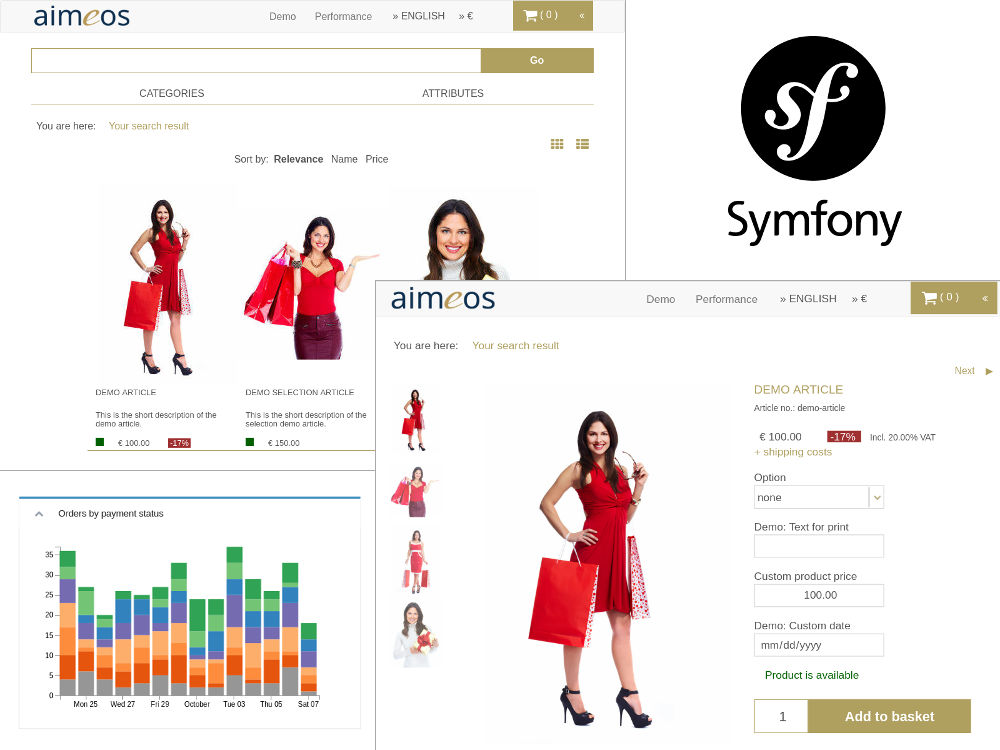The repository contains the Symfony2 web shop bundle integrating the Aimeos e-commerce library into Symfony. The bundle provides controllers for e.g. faceted filter, product lists and detail views, for searching products as well as baskets and the checkout process. A full set of pages including routing is also available for a quick start.
The Aimeos Symfony2 web shop bundle is a composer based library that can be installed easiest by using Composer. Before, the Aimeos bundle class must be known by the registerBundles() method in the app/AppKernel.php file so the composer post install/update scripts won't fail:
$bundles = array(
new Aimeos\ShopBundle\AimeosShopBundle(),
...
);
Make sure that the database is set up and it is configured in your config.yml. Then add these lines to your composer.json of your Symfony2 project:
"prefer-stable": true,
"minimum-stability": "dev",
"require": {
"aimeos/aimeos-symfony2": "dev-master",
...
},
"scripts": {
"post-install-cmd": [
"Aimeos\\ShopBundle\\Composer\\ScriptHandler::installBundle",
"Aimeos\\ShopBundle\\Composer\\ScriptHandler::setupDatabase",
...
],
"post-update-cmd": [
"Aimeos\\ShopBundle\\Composer\\ScriptHandler::installBundle",
"Aimeos\\ShopBundle\\Composer\\ScriptHandler::setupDatabase",
...
]
}
Afterwards, install the Aimeos shop bundle using
composer update
In a production environment or if you don't want that the demo data gets installed, use the --no-dev option:
composer update --no-dev
Note: Alternatively to running the post-install-cmd and post-update-cmd scripts automatically, you can add the lines required for installing the bundle manually. In your ./app/config/config.yml file you need to add "AimeosShopBundle" to the list of bundles managed by the assetic bundle:
assetic:
# ...
bundles: ['AimeosShopBundle']
Furthermore, add the Aimeos routes to your ./app/config/routing.yml
aimeos_shop:
resource: "@AimeosShopBundle/Resources/config/routing.yml"
prefix: /
For setting up the database, please run the following commands afterwards:
php app/console aimeos:setup
php app/console aimeos:cache
Finally, create the ./web/uploads/ directory and make sure it's writeable by the web server:
mkdir ./web/uploads/
chmod 777 ./web/uploads/
In your production environment, you should use these commands as root instead:
mkdir ./web/uploads/
chmod 755 ./web/uploads/
chown www-data:www-data ./web/uploads/
To see all components and get everything working, you also need to adapt your Twig base template in app/Resources/views/base.html.twig. This is a working example using the Twitter bootstrap CSS framework:
<!DOCTYPE html>
<html>
<head>
<meta charset="UTF-8" />
<meta http-equiv="X-UA-Compatible" content="IE=edge">
<meta name="viewport" content="width=device-width, initial-scale=1">
{% block aimeos_header %}{% endblock %}
<title>{% block title %}Aimeos shop{% endblock %}</title>
<link rel="icon" type="image/x-icon" href="{{ asset('favicon.ico') }}" />
<link href="https://maxcdn.bootstrapcdn.com/bootstrap/3.3.2/css/bootstrap.min.css" rel="stylesheet">
{% block aimeos_styles %}{% endblock %}
</head>
<body>
<div class="navbar navbar-static" role="navigation">
<div class="container">
<div class="navbar-header">
<button type="button" class="navbar-toggle collapsed" data-toggle="collapse" data-target=".navbar-collapse">
<span class="sr-only">Toggle navigation</span>
<span class="icon-bar"></span>
<span class="icon-bar"></span>
<span class="icon-bar"></span>
</button>
</div>
</div>
{% block aimeos_head %}{% endblock %}
</div>
<div class="col-xs-12">
{% block aimeos_nav %}{% endblock %}
{% block aimeos_stage %}{% endblock %}
{% block aimeos_body %}{% endblock %}
{% block aimeos_aside %}{% endblock %}
</div>
<script src="https://code.jquery.com/jquery-1.11.2.min.js"></script>
<script src="https://code.jquery.com/jquery-migrate-1.2.1.min.js"></script>
<script src="https://maxcdn.bootstrapcdn.com/bootstrap/3.3.2/js/bootstrap.min.js"></script>
{% block aimeos_scripts %}{% endblock %}
</body>
</html>
Then, you should be able to call the catalog list page in your browser using
http://<your web root>/app_dev.php/list
To simplify development, you should configure to use no content cache. You can do this in the ./app/config/config_dev.yml file of your Symfony application by adding these lines:
aimeos_shop:
classes:
cache:
manager:
name: None
The Aimeos Symfony2 bundle is licensed under the terms of the MIT license and is available for free.

